Day 2: Base Camp to Olympia
After breakfast, Ranger Dylan does a shakedown of our gear. In a shakedown, you take everything from your backpack and spread it out for the ranger to look at. He then advises you on what you should and shouldn’t take on the trek.
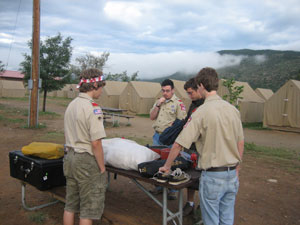 Kevin, Blake and Travis are in charge of the crew gear shakedown. |
We haul our cots out of our tents and put all our stuff on them.
Luckily, the shakedowns we performed on our prep hikes at home have paid off. Dylan is impressed with our gear and nothing has to stay behind. We’re proud that nobody tries to take anything ridiculous—you know, like a hatchet, hair dryer or French-English dictionary.
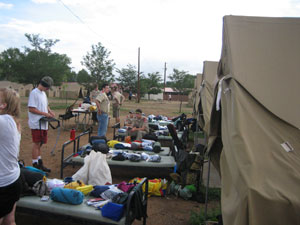 Shakin’ it up at the individual gear shakedown. No hair dryers here. |
We then have our official Philmont crew photo taken. Note the ominously approaching cloud where the Tooth of Time is supposed to be. A sign of things to come.
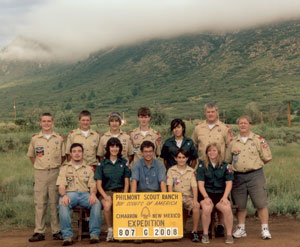 Our official Philmont crew photo. |
The day drags by as we hurry up and wait for the bus that will take us to the trailhead.
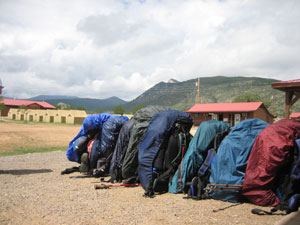 The crew’s packline ready to go. |
Finally, we board the bus at 2:30 p.m. and take off for the Rayado Turnaround trailhead, where we unload. At last! We’re on the trail!
It immediately starts to rain.
Another thing that starts immediately is our ranger training. Near the trailhead, we encounter what’s called a Philmont “Red Roof Inn.” That is, an outhouse with—you guessed it—a red roof. You wouldn’t think that anybody would need to be taught how to use one, but Dylan gives us some helpful tips. (One of them: First scrape around the seat opening with a stick to knock off any creepy crawlies.)
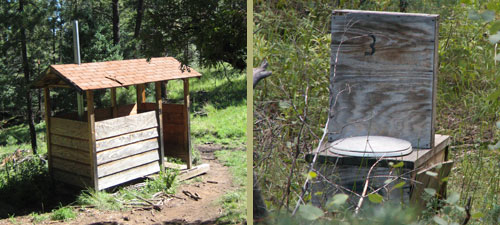 One of Philmont’s finest. Red Roof Inns are the the luxury models. Philmont campsites can also feature what’s called “pilot to bombardiers,” a more primitive option. |
Not far down the trail, we come to our first water crossing. What is normally a small creek has become swollen and swift running from recent (and current) rains. For safety reasons, we can’t cross if the water is above the smallest crew member’s knees, so we reroute and find another crossing. There’s no bridge, and any stepping rocks are now underwater. We have to cross in mid-calf-high water.
Our boots now are completely soaked within only the first two hours of our trek.
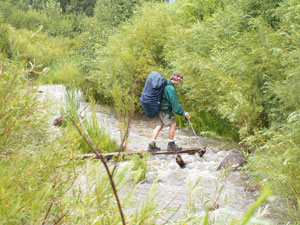 One crossing has a footbridge that Kevin carefully negotiates with the help of his trekking pole. |
“Welcome to Philmont,” Blake says as we squish along. “Rain is part of the experience.”
Blake knows what he’s talking about. The Eagle Scout went on a Philmont trek three years ago.
“Well, August is monsoon season at Philmont,” Ranger Dylan says, a little too cheerfully. “You can expect rain between noon and two almost every day. Plus, we’re getting remnants of Hurricane Eduard.” Great.
We don’t have to squish very far before arriving at our first campsite, Olympia. Now ranger training goes into high gear.
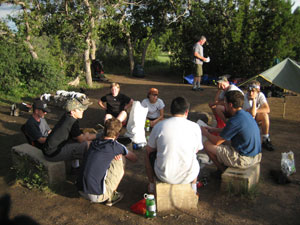 Dylan kicks ranger training into high gear. |
“The most important thing,” Dylan explains, “is establishing what is called the ‘Bearmuda Triangle.’ ” Bear? My ears perk up.
At each campsite, the dining fly is set up and backpacks stored at one point of this triangle. At the second point of the triangle is the sump, a pipe sticking out of the ground where dishes, pots and pans are washed, kept and food waste collected. At the third point of the triangle, bear bags with all the crew’s “smellables” (food, anything with a scent such as soap, Nalgene bottles containing Gatorade, even duct tape) are hauled up by ropes out of the reach of bears.
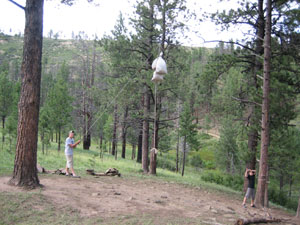 Trevor and Christian make sure the “smellables” are out of bear reach. |
The idea is that if bears enter your campsite, they will stay within this triangle hunting for anything good to eat. Luckily, black bears—the kind at Philmont—don’t usually consider people good to eat. Most times people are attacked, they have food or other smellables in their tent or clothes. And if you do a good job setting up your Bearmuda Triangle, bears won’t mess with any of your stuff.
We then are sure to follow procedures and set up our tents at least 50 feet away from the Bearmuda Triangle.
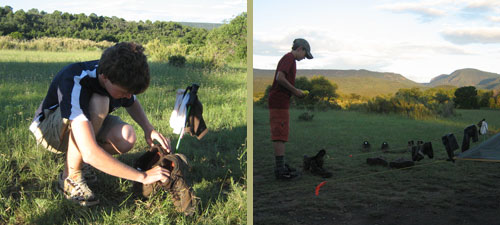 Travis and Christian perfect the art of drying hiking boots and socks. |
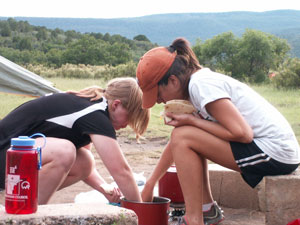 Kendall and Tonie use tortillas to help clean out the cooking pot. |
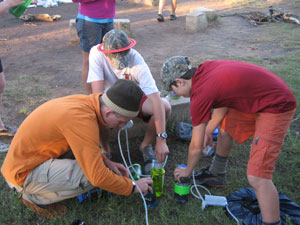 Charlie, Trevor and Christian filter water from nearby Rayado Creek, while everybody else sets up camp. |
Soon we find out firsthand why it’s called Philmont Scout “Ranch.” Philmont includes thousands of acres of working ranch with horses, cattle, burros and buffalo. We had encountered horses right along the trail on our hike to Olympia. After we set up our tents tonight, a herd of cattle lumbers smack dab through the middle of our tent site.
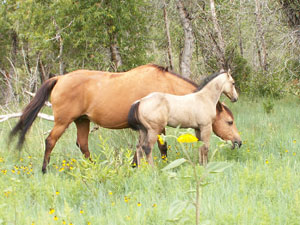 Horses along the trail. |
As I watch the cows traipse through our campsite, I think back to when I pitched my tent. I’m pretty sure I’ve staked one corner of my tent right through a cow pie. At the time I thought it was just a very round—and mushy—mud pie. I’ll keep telling myself that that’s what it is.
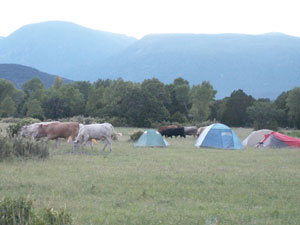 A herd of cattle traipses through our campsite. |
Tonight I start what will become a trek habit, going to sleep in fits and starts. It goes like this: As I finally begin to drift off, I think, What was it that I was worrying about? Oh, yeah—BEARS. And I’m wide awake again.
When I was at Philmont we got at least a quarter of the anual rainfall in three days and I do not exagerate! In the day 1 post it says there was a huge bear problem at Ponil. My crew went threw there and no one said anything about bears.
cool horses